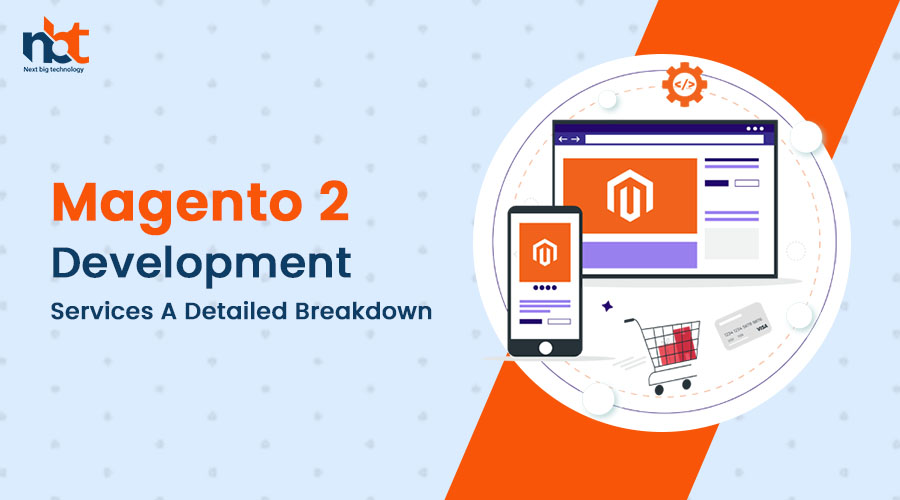Introduction: Magento 2 is a powerful and feature-rich eCommerce platform that provides businesses with the tools to create scalable and customizable online stores. If you’re considering using Magento 2 for your eCommerce website, it’s important to understand the various components and services involved in Magento 2 development. In this blog, we will provide a detailed breakdown of Magento 2 development services, exploring the essential elements that contribute to the successful implementation of this platform.
- Magento 2 Installation and Configuration: The first step in Magento 2 development is the installation and configuration of the platform. This includes setting up the necessary server requirements, database configuration, and installation of the Magento 2 software. Key aspects include:
a) Server Environment Setup: Ensuring that the server meets the minimum requirements for Magento 2 installation, including the appropriate PHP version, database compatibility, and necessary extensions.
b) Database Configuration: Creating and configuring the database for the Magento 2 installation, including setting up database credentials and ensuring the database is properly optimized.
c) Installation of Magento 2: Deploying the Magento 2 software on the server, including the necessary files and directories, and running the installation wizard to configure basic store settings.
- Magento 2 Theme Development and Customization: The visual appearance and user experience of your Magento 2 store are crucial for attracting and engaging customers. Key aspects of theme development and customization include:
a) Theme Selection: Choosing a suitable pre-built Magento 2 theme or creating a custom theme that aligns with your brand identity and provides a user-friendly interface.
b) UI/UX Customization: Customizing the theme’s layout, colors, typography, and design elements to create a visually appealing and intuitive user experience.
c) Responsive Design: Ensuring that the theme is responsive and optimized for different devices and screen sizes to provide a consistent and seamless shopping experience.
- Extension Integration and Customization: Magento 2 offers a wide range of extensions and modules that enhance the functionality of your eCommerce store. Key aspects include:
a) Extension Selection: Identifying and integrating the necessary extensions to add features such as payment gateways, shipping methods, product reviews, and marketing tools.
b) Custom Extension Development: Creating custom extensions or modifying existing ones to meet specific business requirements and integrate seamlessly with the Magento 2 platform.
c) Extension Compatibility: Ensuring that the installed extensions are compatible with the current version of Magento 2 and do not conflict with each other, providing a stable and reliable website.
- Catalog Management and Product Configuration: Efficient catalog management is crucial for managing products and organizing them effectively on your Magento 2 store. Key aspects include:
a) Product Import and Configuration: Importing product data from various sources and configuring product attributes, categories, pricing, and inventory settings.
b) Content Management: Creating and managing content pages, banners, and promotional blocks to showcase products and engage customers.
c) Advanced Product Options: Implementing advanced product options such as configurable products, custom options, and product bundles to provide flexibility and variety to customers.
- Payment Gateway and Shipping Integration: Seamless payment and shipping integration is essential for a smooth customer experience. Key aspects include:
a) Payment Gateway Integration: Integrating popular payment gateways to securely process online transactions, supporting various payment methods and ensuring PCI compliance.
b) Shipping Method Configuration: Configuring shipping methods, rates, and rules based on location, weight, and other variables to provide accurate shipping options to customers.
- Performance Optimization and Security: Optimizing the performance and ensuring the security of your Magento 2 store are critical for a successful online presence. Key aspects include:
a) Caching and Performance Tuning: Implementing caching mechanisms, optimizing database queries, and leveraging server-side technologies to improve the speed and performance of the website.
b) Security Measures: Implementing security best practices, including secure user authentication, data encryption, regular security patches, and monitoring for potential vulnerabilities.
c) Regular Updates and Maintenance: Performing regular updates to the Magento 2 platform, extensions, and security patches to ensure that your website remains secure, stable, and up to date.
Conclusion: Magento 2 development services encompass various crucial components that contribute to the successful implementation and customization of your eCommerce store. From installation and configuration to theme development, extension integration, catalog management, payment gateway and shipping integration, and performance optimization, each element plays a vital role in creating a robust and user-friendly Magento 2 store. By partnering with experienced Magento 2 developers, businesses can leverage their expertise to create a scalable, customizable, and visually appealing eCommerce platform that caters to their specific business needs. Whether you’re starting a new eCommerce venture or looking to enhance your existing store, investing in professional Magento 2 development services is key to achieving long-term success in the competitive online marketplace.

















